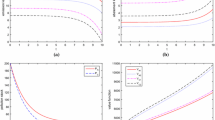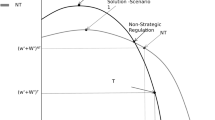Abstract
When environmental damages from emissions are spatially nonuniform, permit trading has been modeled most often as a “pollution offset program” in which emission permits are traded between agents, subject to constraints on ambient air quality. To date the institution envisioned to implement such a program involves trading on a bilateral and sequential basis. However, simulation studies indicate that the sequence of trades may alter the outcome and undermine the cost savings from a pollution offset program. This paper identifies a design for the trading institution that tends to overcome this phenomenon and improve the efficiency of equilibria obtained in a simulation model. We model a bilateral trading process for the reduction of sulfur dioxide emissions with a stochastic description of the sequence of trades within groups of nations in Europe. When trading takes place between disaggregated, stylistic representations of economic enterprises, rather than between national governments, a significantly greater portion of potential savings is achieved. In fact, under most sets of assumptions, approximate first order stochastic dominance is achieved wherein the more decentralized the trading agents, the greater the expected savings from a trading program.
Similar content being viewed by others
References
Alcamo, Joseph et al., eds. (1990), The RAINS Model of Acidification. Boston: Kluwer Academic Publishers.
Atkinson, Scott E. and Donald H. Lewis (1974), 'A Cost-Effectiveness Analysis of Alternative Air Quality Control Strategies', Journal of Environmental Economics and Management 1, 237–250.
Atkinson, Scott E. and Tom Tietenberg (1991), 'Market Failure in Incentive Based Regulation: The Case of Emission Trading', Journal of Environmental Economics and Management 21, 17–31.
Bartels, Carlton W., Donald B. Marron and Michael I. Lipsky (1993), 'Clean Air, Clear Market', Public Utilities Fortnightly (June), 14–16.
Baumol, William J. and Wallace E. Oates (1988), The Theory of Environmental Policy. New York: Cambridge University Press, Second edition.
Berg, Sanford and John Tschirhart (1988), Natural Monopoly Regulation. Cambridge University Press.
Brown, S. J. and D. S. Sibley (1986), The Theory of Public Utility Pricing. Cambridge University Press.
Bohi, Douglas R. (1994), 'Utilities and State Regulators: Are They Failing on Allowance Trading?', The Electricity Journal 7(2) (March), 20–27.
Bohi, Douglas R. and Dallas Burtraw (1992), 'Utility Investment Behavior and the Emission Trading Market', Resources and Energy 14(1/2) (April), 129–156.
Burtraw, Dallas (1994), 'Designating Trading Agents for Environmental Agreements in a Competitive International Economy', in F. Fø rsund and G. Klaassen, eds., Economic Instruments For Air Pollution Control. Kluwer Academic Publishers.
Dudek, Daniel J. and John Palmisano (1988), 'Emissions Trading: Why Is This Thoroughbred Hobbled?', Columbia Journal of Environmental Law 13, 217–256.
Hahn, Robert W. (1986), 'Trade-Offs in Designing Markets with Multiple Objectives, Journal of Environmental Economics and Management 13, 1–12.
Hahn, Robert W. (1989), 'Economic Prescriptions for Environmental Problems: How the Patient Followed the Doctor's Orders', Journal of Economic Perspectives 3(2) (Spring), 95–114.
Hahn, Robert W. and Gordon L. Hester (1989), Where Did All the Markets Go? An Analysis of EPA's Emissions Trading Program', Yale Journal on Regulation 6, 109–153.
Hausker, Karl (1992), 'The Politics and Economics of Auction Design in the Market for Sulfur Dioxide Pollution', Journal of Policy Analysis and Management 11(4) (Fall), 553–572.
Kerr, Suzi C. and David Maré (1995), 'Market Efficiency and Tradeable Permit Markets with Transaction Costs: Empirical Evidence from the United States Lead Phasedown'. Harvard University Economics Department, mimeo.
Kete, Nancy (1992) The Politics of Markets: The Acid Rain Control Policy in the 1990 Clean Air Act Amendments. Ph. D. Dissertation, Baltimore: Johns Hopkins University.
Klaassen, Ger (1994), 'Trading Sulphur Emission Permits in Europe Using an Exchange Rate', in Ekko C. van Ierland, ed., International Environmental Economics: Theories, Models and Applications to Climate Change, International Trade and Acidification. Amsterdam: Elsevier.
Klaassen, Ger and Markus Amann (1992), 'Trading of Emission Reduction Commitments for Sulfur Dioxide in Europe', SR–92–03, Laxenburg, Austria: International Institute for Applied Systems Analysis (May 18).
Kruitwagen, Sonja (1992), 'Tradeable Permits for SO2-emissions in Europe: A Pollution Offset Experiment', Wageningen Economic Papers, Wageningen Agricultural University, The Netherlands.
Kruitwagen, Sonja, Eligius Hendrix and Ekko van Ierland (1993), 'Tradeable SO2 permits: Guided Bilateral Trade in Europe', in Ekko C. van Ierland, ed., International Environmental Economics: Theories, Models and Applications to Climate Change, International Trade and Acidification. Amsterdam: Elsevier.
Krupnick, Alan J. et al. (1983), 'On Marketable Air-Pollution Permits: The Case for a System of Pollution Offsets', Journal of Environmental Economics and Management 10(3) (September), 233–247.
Ledyard, John O. and Kristin Szakaly-Moore (1994), 'Designing Organizations for Trading Pollution Rights', Journal of Economic Behavior and Organization 25, 167–196.
Montgomery, W. David (1972), 'Markets in Licenses and Efficient Pollution Control Programs', Journal of Economic Theory 5, 395–418.
Netusil, Noelwah R. and John B. Braden (1993), 'Market and Bargaining Approaches to Nonpoint Source Pollution Abatement Problems', Water Science Technology 28(3- 5), 35–45.
Sandnes, Hilde (1993), 'Corrigendum to EMEP/MSC-w Report 1/92 (Appendix C)', EMEP/MSC-W Report 1/92, The Norwegian Meteorological Institute.
Spulber, Daniel F. (1985), 'Effluent Regulation and Long-Run Optimality', Journal of Environmental Economics and Management 12, 103–116.
Stavins, Robert N. (1995), 'Transaction Costs and Tradeable Permit Markets', Journal of Environmental Economics and Management (forthcoming).
Tietenberg, T. H. (1985), Emissions Trading: An Exercise in Reforming Pollution Policy. Washington DC: Resources for the Future.
Tietenberg, T. H. (1990), 'The Implementation and Effectiveness of Emissions Trading in the U. S.', Department of Economics Working Paper, Colby College (January).
Tripp, James T. B. and Daniel J. Dudek (1989), 'Institutional Guidelines for Designing Successful Transferable Rights Programs', Yale Journal on Regulation 6, 369–391.
Author information
Authors and Affiliations
Rights and permissions
About this article
Cite this article
Burtraw, D., Harrison, K.W. & Turner, P. Improving Efficiency in Bilateral Emission Trading. Environmental and Resource Economics 11, 19–33 (1998). https://doi.org/10.1023/A:1008236224091
Issue Date:
DOI: https://doi.org/10.1023/A:1008236224091




